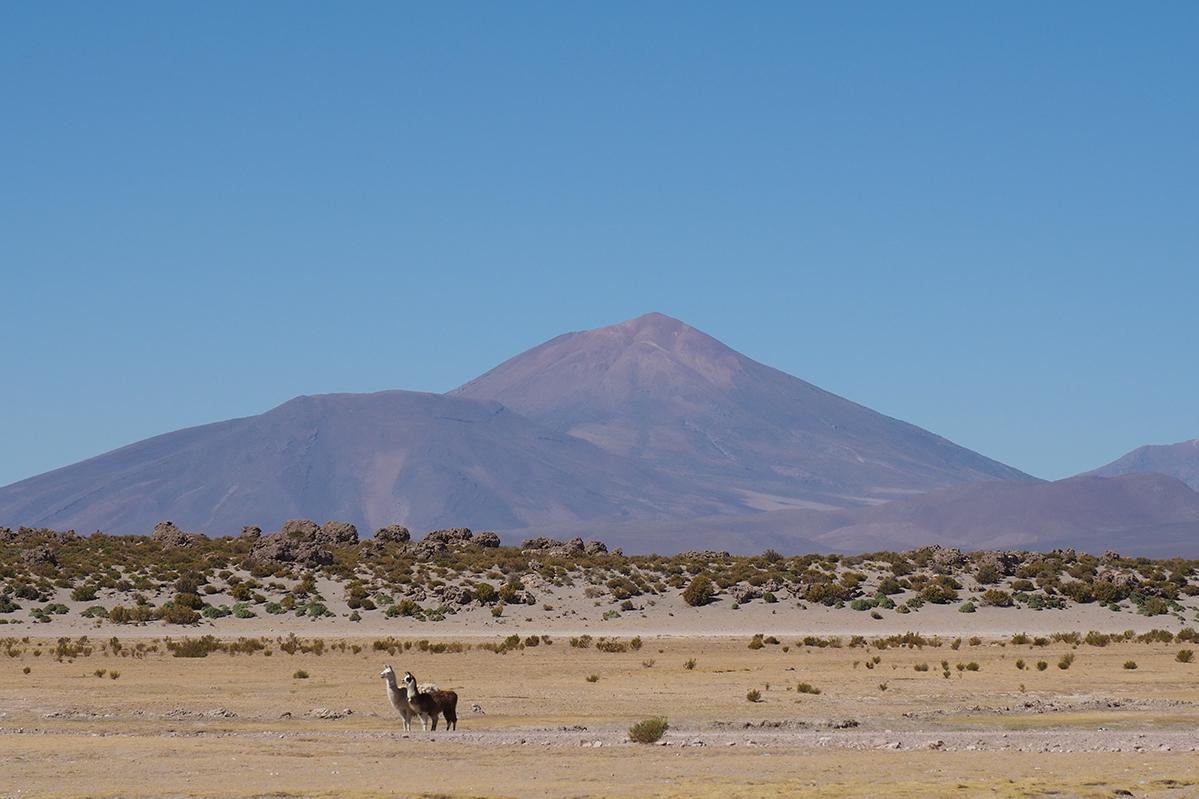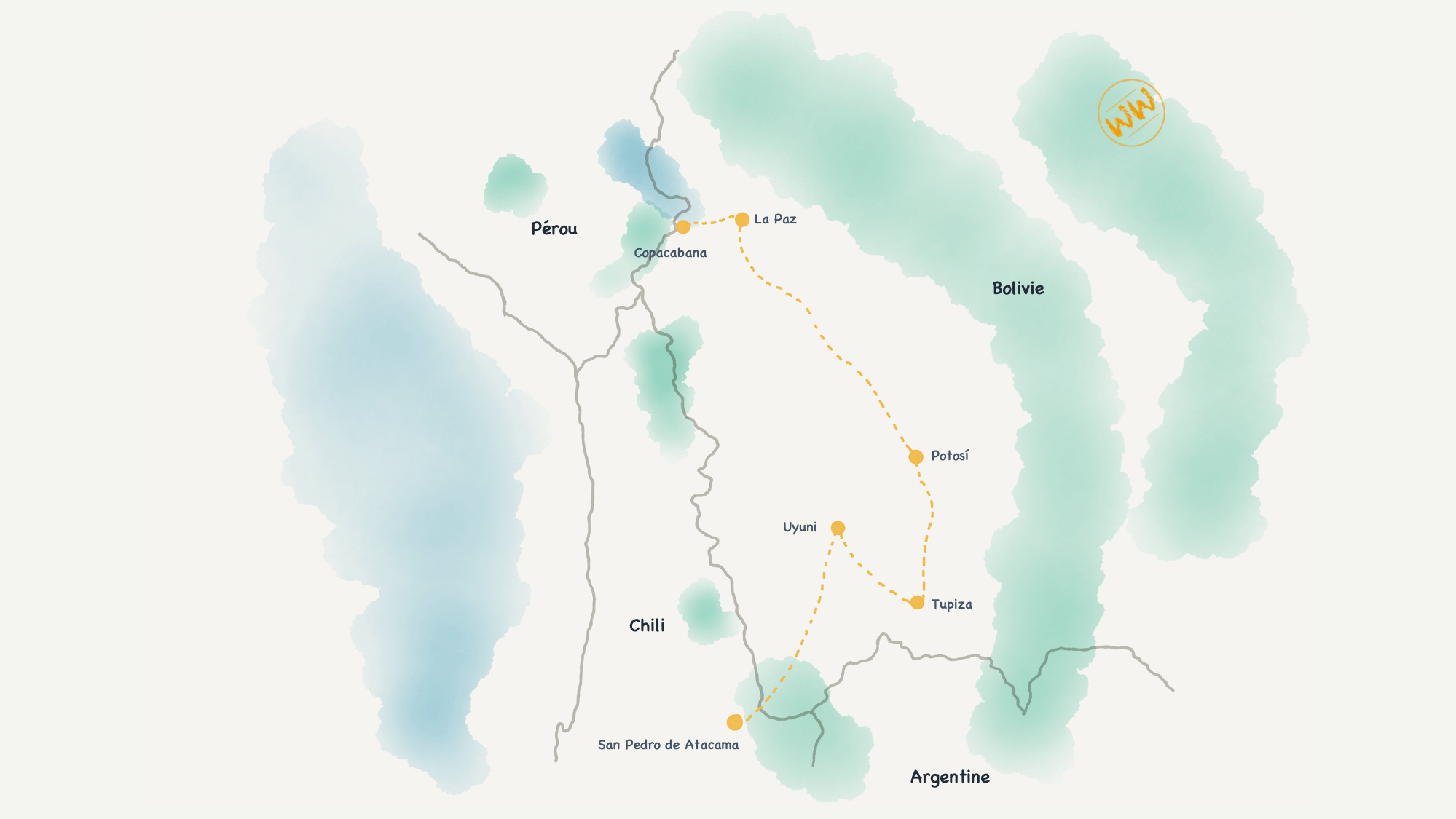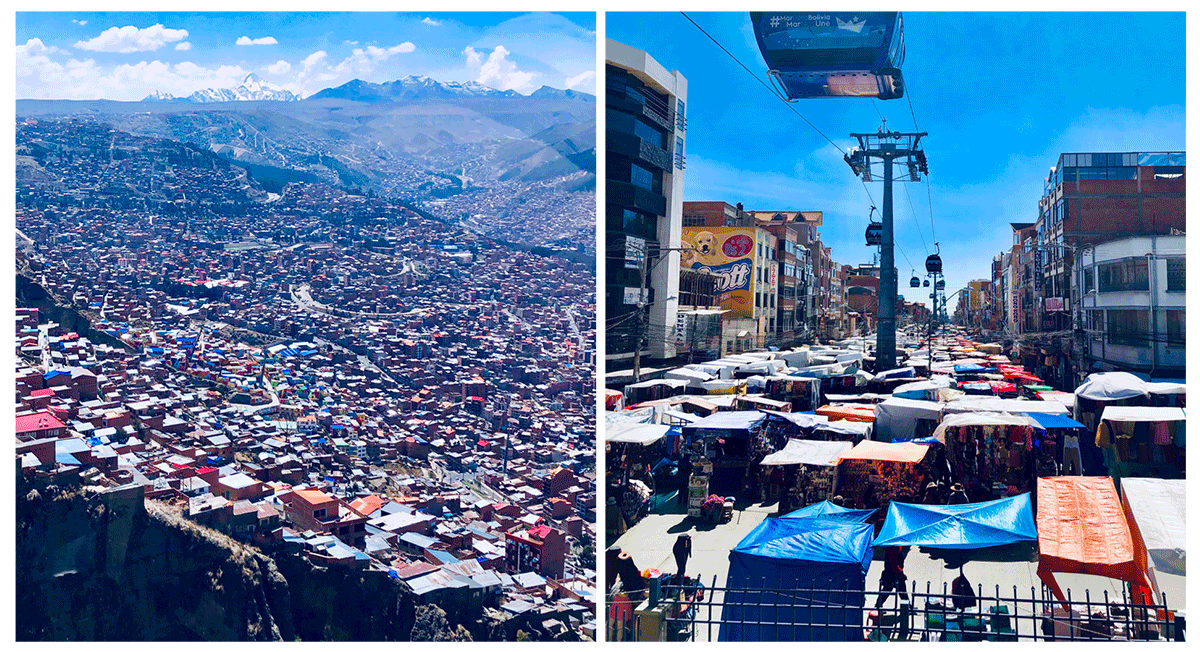Reading time: 10 minutes
Find in 3 minutes a summary of our 8 days in Bolivia! On the program: lagoons, geysers, lamas and pink flamingos...
We leave Peru and go along the Titicaca lake for our first steps in Bolivia, this incredible country that we will finally have little time to discover (eight days)... South America is big and there are so many things to explore! We chose to focus on the South-West of the country until the Chilean border, our next step. No regrets for this time, but we will surely come back...
First stage (2 days, 1 night): Copacabana, the city by the lake
Wedged between the mountains and Lake Titicaca, the town of Copacabana is only a few kilometres from the Peruvian border. After the intense rhythm of our stay in Peru, we spend two days there in a calm natural setting.
Practical information
Where to sleep?
There is no lack of hotels in Copacabana, which lives mostly from tourism (list available here ). We choose the hotel Aldea del Inca (300 Bolivianos per night for two, breakfast included, that is to say about forty euros; to be paid in cash), which seems to us to be the most accessible if not the best rated... Which is not quite true! Not a great success, neither on the accessibility nor on the overall comfort of the hotel...
Apart from the accessibility criteria that we were not able to test, we recommend the Ecolodge Las Olas, whose surprising exterior design hides rooms of incredible comfort with an exceptional view of the lake (testimonies from other travellers).
Where to eat?
The restaurants follow one another and look the same in the streets of the city... We particularly appreciate the Gourmet Ali: an excellent Bolivian cuisine, but a long service time... It is better to go there early (you will not be served faster, but at least you will have time) ! For lunch, we taste a trout caught during the day in one of the huts along the lake at the entrance of the city centre: a delight!
We recommend
In a simple way, this town is made for resting and enjoying the view! We are dazzled by the colours of the sunset on the lake from the harbour... For the rest, we decide to forget about two hikes that are a bit too sporty for the energy of the moment, but that other (able-bodied) travellers recommend to us:
- The half-day excursion to Isla del Sol (the hike starts with a hundred steps... Not this time!),
- Climbing Cerro Calvario, a stone's throw from the city, for its exceptional view of the lake.
In a wheelchair
Copacabana is one of the least accessible cities we have visited so far...
Firstly, because it is perched on a fairly high hill and the streets slope downwards accordingly... Some of them look as if they could not be taken by car because they are so steep! So be very careful when choosing your hotel: as soon as you leave the lake front, there is a good chance that you will have to take a taxi to get back to your accommodation, even if it seems close.
Secondly, because the topography is not optimal, many establishments have steps at the entrance to compensate for the difference in height. These are high and sometimes difficult to pass, depending on their condition. Not to mention the many roof terraces that can only be reached by narrow stairs with uneven steps...
In short, the lake front can be done relatively easily with a third wheel and cross-country tyres, but the rest of the city clearly requires outside help and is difficult to cover on foot, especially at this altitude!
Second stage (2 days, 2 nights): La Paz, in the heart of the Altiplano
We leave Copacabana at the end of the day for our last stop with Bolivia Hop. Direction: La Paz! Four hours of driving which includes a ferry crossing of Lake Titicaca and many curves on roads that are not always well maintained... or even almost non-existent!
The arrival in La Paz at night is breathtaking! The lighted windows of the houses cover the inky black mountainsides with thousands of points of light: an excellent way to realise the size of this city of more than a million inhabitants in a country that counts eleven...
Practical information
Where to sleep?
After more than two weeks of rough accessibility, we are exhausted! We choose the only apartment hotel in the centre of the city that seems to offer a really accessible bathroom, the Camino Real. A very comfortable flat, well located, with an excellent quality of services and a well equipped kitchen, unfortunately a bit expensive for the country (about 750 Bolivianos a night for two, breakfast included).
Where to eat?
We admit that after almost three weeks of travel, we are taking advantage of our hotel with a kitchen... To cook! But as we probably won't be there to cook for you during your stay, we give you these two little gastronomic tips:
- La Tranquera (our hotel's restaurant) serves excellent grilled meats and is particularly famous for its llama pieces: a must-try!
- For a (very) cheap lunch on the go, take advantage of your passage in El Alto. There are many food stalls and you can enjoy a substantial and delicious dish for a dozen Bolivianos... That is less than 2 Euros!
How to get around?
The cable car is a great way to see the city! Each cable car line is connected to another and allows you to fly over La Paz in all directions to admire it from above while stopping in the neighbourhoods that interest you (and it is 100% accessible)... An experience as much as a means of transport!
Walking is also possible, but the difference in altitude is significant and La Paz is a very large city... To go from one district to another, transport is unavoidable and the extremely dense traffic does not encourage the use of buses and taxis!
We recommend
As in Lima, we had mixed feelings in La Paz. Between a feeling of too big, too busy and some nice surprises. Here is what we preferred:
The Alto market (1/2 day)
This is the largest and highest market in South America. Located in the district of the same name, it spreads over a large part of the plateau, accessible by cable car via the red line. There are not many tourists here: it is a local market! You will find absolutely everything here, except souvenirs: people come here mainly for the view and the local colour.
We prefer to warn you however: avoid taking your backpacks and be careful with your things! When you say few tourists, you also mean tourists who can be spotted: pickpockets are watching... No major risk from our point of view, but simply a little attention... As in the rest of the city, by the way.
The centre (1/2 day)
The centre of La Paz has a variety of architecture. Not necessarily all in good condition, the buildings are not necessarily all exciting. However, we really enjoyed walking in the centre and discovering the Plaza das Armas and the Calle Jaen, a nice coloured and pedestrian street which allows to take a break in the agitation of the city...
In a wheelchair
A simple summary: fortunately there is the cable car! If the cable car is fully accessible (lifts, assistance by an agent from the arrival at the station to the entry in the cabins and then from the exit of the cabin to the exit of the station), it is the only moment of respite that you will find in La Paz (good to know also: you will find accessible toilets in all the stations).
Apart from the Alto district which is rather flat, the city is a tangle of (very) sloping streets with pavements sometimes strewn with steps... The few ramps at the entrance of some shops and the lowered pavements in some places are not up to the task of compensating for the rest... We liked the sporty challenge of the visit, but it's definitely a city in which we couldn't have spent much time!
We take a night bus with the company Trans Copacabana, which takes us to Potosí in about ten hours (19 USD per person). Comfortable seats, smooth ride and good temperature despite the lack of blankets... We would have preferred to avoid the cockroaches though! Maybe a lack of luck, but it seems to be one of the best companies to make the trip according to the feedback we had from other travellers... Tickets can be booked here. A little advice: arrive well in advance at the bus station to choose your seats and take the lower ones: there is often more space.
Third stage (2 days, 2 nights): the peaks of Potosí
Perched at an altitude of 4,000 metres (see our article: 5 tips for travelling at altitude), Potosí is the highest city in the world with over 100,000 inhabitants! Mainly a mining town, it is also very popular for its historic centre and its colonial architecture, which is a UNESCO heritage site. However, it remains less known than Sucre, which is larger and more touristic.
Practical information
Where to sleep?
We choose theHostal Colonial, a small hotel with a few rooms in a charming colonial style (550 Bolivianos per night for two, breakfast included)!
Its pluses: its location in the centre, its copious and delicious breakfast, the kindness of its reception team and the beauty of its setting.
Its minuses: its price, a little high for the area (but equal to the services after all)... And its accessibility. Or rather its non-accessibility. Between the steps at the entrance and the bathroom with a too narrow door, our sport of the day was assured before it even started... Too bad, but considering the pluses we don't regret it!
Where to eat?
There are many restaurants in the lively streets of Potosí... Except on Sundays! Besides, it's simple, nothing is open on that day (ask our friends Ninon and Sylvain, alias the Two Pigeons, they agree with us!
If we are not particularly impressed by the restaurants in which we dine, we do have an excellent lunch on the terrace of the Phisqa Warmis: varied and quality dishes and a pleasant welcome to boot!
We recommend
First of all, we recommend not to go there at the weekend... If Saturdays remain rather lively, everything closes on Sundays, including the main centres of interest of the city!
The Casa de la Moneda, which traces the history of coinage in this mining town, is well worth a visit... Including its patio, which is free to enter! It is incidentally the only "accessible" part of the museum. We put inverted commas on it because there are three steps at the entrance, but the rest of the visit being on the first floor without a lift, it seems to us to be the lesser evil...
In the centre, the market and the colourful alleys are the most lively visits to make. Given the size of the city, we recommend you not to linger there! We take advantage of these two full days to recharge our batteries and take the time to work on our first articles and videos... A time well used for us!
In a wheelchair
Like Copacabana and La Paz, Potosí is a city on a mountainside... And even higher than the two previous ones! Beyond the sometimes difficult slope, we didn't find any place perfectly accessible apart from the banks and churches, whose efforts in this field are impressive! The pavements of the central squares are lowered, but most of the monuments and tourist establishments have not followed suit: the market and the Casa de la Moneda in particular have entrances with several steps and it is not possible to access them if you cannot get out of your wheelchair...
Fourth stage (1 day, 1 night): Tupiza, at the gateway to the desert
We arrive in Tupiza in the middle of the day... Not to do much! Less known than Uyuni for the departures of excursions in the Salar and the South Lipez, Tupiza is a small and quiet town which allows us to start the tours against the current... And to meet less people (although more and more tourists, especially French, choose it as a starting point).
Practical information
Where to sleep?
We were looking for a place to spend a quiet afternoon before our three day expedition... And we found it! The Mitru hotel has the advantage of being in the centre of Tupiza (so close to the tourist agencies) and has a large interior courtyard and a swimming pool: the perfect place for a simple stopover! It cost us 455 Bolivianos, including breakfast.
Like almost all our hotels since our arrival in Peru and Bolivia, is it necessary to specify that it is not accessible...? A step at the entrance of the room (quite high this one), a step to reach the bathroom, a too narrow door... Everything is there! Fortunately, we only spend one night there... But we have to admit that Bolivia still has a lot of progress to make in terms of accessibility, even more than its Peruvian neighbour!
Where to eat?
Walking along the street, we pass a few restaurants... And we are surprised to see that they are all pizzerias! Our favourite : the Torre Italiana. Nothing exceptional but a very warm welcome and tasty and copious pizzas; finally, we don't need much more.
We recommend
Do not stay there! No need to spend more than half a day in this city, it is not really interesting... If you want to spend your time, horse riding in the surrounding canyons is worth it! For our part, we reserve this activity for Chile or Argentina...
Fifth stage (3 days, 2 nights): Salar de Uyuni and South Lipez
Practical information
When to go?
South West Bolivia is mostly mountainous and the altitude makes the winters freezing! In summer, the rainy season (November to February) makes part of the Salar inaccessible and the roads, muddy, can be closed in places. We therefore recommend that you plan your trip in March/April or, like us, in early spring (September/October). The climate is changeable: even in spring, snowfall or heavy rainfall can make the journey hazardous... The joys of nature!
Organised excursions: how does it work?
Many agencies offer turnkey excursions lasting three to five days. Departures are from Uyuni or Tupiza with a 4×4 from the agency, a guide/driver and a cook, who takes care of preparing meals throughout the trip.
The accommodation is basic in the middle of the desert: simple rooms with no heating (bring duvets and warm clothes), optional showers, cold water and shared toilets...
Each 4×4 can take from 2 to 6 people. Unless you ask for a private tour to be alone, the number of people in the car can change up to the last moment according to the requests!
Pierre's chair and our luggage taking up a bit of space, we choose to take a 3 day private tour with the agency Alexandro Adventure Travel. For 870 USD, we leave Tupiza on Wednesday at 9am, drive to Uyuni on the first day, pass from lagoon to lagoon on the second day and reach the Chilean border in the middle of the day on Friday after having seen the sunrise on the geysers. An incredible experience!
Please note: the exploration of these great spaces is only done by tracks, of more or less good quality depending on the places and the recent climatic hazards. Between the sand and the stones, the vehicles are not always in perfect condition and mechanical breakdowns and punctures are not rare... This cost us a few hours of waiting on the first day while our guide went back and forth to Uyuni to get parts and a mechanic, you have to get used to it... Check out the reviews of the different agencies before selecting yours: attractive prices are sometimes a reflection of vehicles in very poor condition, which can quickly become dangerous, or at least very frustrating if returns to square one are necessary...
We recommend
Whether you choose one of these excursions or go on your own (be careful though: don't expect to find road signs on the desert tracks, it's easy to get lost, the climate is arid and the nights are cold!), here are the must-sees in South Bolivia in our opinion:
- The Salar of Uyuni at sunrise
A 4am wake-up call quickly forgotten when you see what awaits you! The changing colours of the sky contrast with the immaculate white of the Salar... An incredible sight! - Inka Wasi
The perfect place for breakfast after sunrise. Avoid the car park where many agencies gather and sit a little further away to enjoy the growing light on this cactus-covered island of land in the middle of the Salar. - The Laguna Colorada
A huge lake whose waters are divided between dark blue (so far, no surprise), white... and red! Incredible in itself, but you can also add the ballet of the pink flamingos that live on the lake... A real highlight!
- The Laguna Verde
On the Chilean border (but on the Bolivian side), this lake turns emerald green as soon as the wind picks up. In calm weather, the perfect reflection of the volcano in the clear water is just as impressive... - The Sol de Mañana geysers
Again, at sunrise! The low temperatures (-12 degrees for us) favour the smoke that escapes from the faults filled with boiling water. There are no words to describe the beauty of the whole thing when the sun shines behind the mountains...
Ideally, take three or four days to enjoy it... Given the diversity of the landscapes, you won't have time to get bored!
In a wheelchair
Lost in the middle of the desert in a country where accessibility is not yet a priority, we find that there is no infrastructure to make the various sites accessible. This is the real adventure! The advantage is that nothing disturbs the raw nature that surrounds us... And that's why we are here! The disadvantage... is that nothing is accessible in the strict sense.
Nevertheless, the tours are done in 4×4: the guides being able to help, it is relatively "simple" to visit the region by choosing where you want to go down. A third wheel is of course essential and help may be needed depending on the terrain (sand, stones, grass...). Note: 4×4's are quite high, so multiple transfers can be tiring (classic cars are not adapted). A good physical condition is necessary to do these tours, unless you rent or buy a converted vehicle (4×4 mandatory).
In our next article
We go around the volcano that rises behind the Laguna Verde and enter the "No Man's Land" that separates Bolivia from Chile. In the middle of this desert, streaked with tracks dug by 4×4's tyres, stands the border post: four walls and a tin roof. We cross the shelter which seems derisory in the heart of this windswept desert immensity and enter Chile for our next step: the Atacama desert!
















